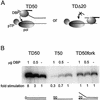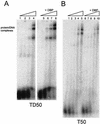Adenovirus type 5 DNA binding protein stimulates binding of DNA polymerase to the replication origin
- PMID: 12502807
- PMCID: PMC140850
- DOI: 10.1128/jvi.77.2.915-922.2003
Adenovirus type 5 DNA binding protein stimulates binding of DNA polymerase to the replication origin
Abstract
The adenovirus (Ad) DNA-binding protein (DBP) is essential for the elongation phase of Ad DNA replication by unwinding the template in an ATP-independent fashion, employing its capacity to form multimers. DBP also enhances the rate of initiation, with the highest levels obtained at low concentrations of Ad DNA polymerase (Pol). Here, we show that stimulation of initiation depends on the template conformation. Maximal stimulation, up to 15-fold, is observed on double-stranded or viral TP-containing origins. The stimulation is reduced on partially single-stranded origins and DBP does not enhance initiation any more once the origin is completely unwound. This suggests a role for DBP in origin unwinding that is comparable to its unwinding capacity during elongation. However, mutant DBP proteins defective in unwinding and elongation can still enhance initiation on ds templates. DBP also stimulates the binding of nuclear factor I (NFI) to the origin and lowers the K(m) for coupling of the first nucleotide to the precursor terminal protein by Pol. Mobility shift experiments reveal that DBP stimulates the binding of Pol on double-stranded origin and nonorigin DNA but not on single-stranded DNA. This effect is specific for DBP and is also seen with other DNA Pols. Our results suggest that, rather than by origin unwinding, DBP enhances initiation by modulating the origin conformation such that DNA Pol can bind more efficiently.
Figures







Similar articles
-
Multimerization of the adenovirus DNA-binding protein is the driving force for ATP-independent DNA unwinding during strand displacement synthesis.EMBO J. 1997 Mar 17;16(6):1455-63. doi: 10.1093/emboj/16.6.1455. EMBO J. 1997. PMID: 9135160 Free PMC article.
-
ATP-independent DNA unwinding by the adenovirus single-stranded DNA binding protein requires a flexible DNA binding loop.J Mol Biol. 1998 Apr 10;277(4):825-38. doi: 10.1006/jmbi.1998.1652. J Mol Biol. 1998. PMID: 9545375
-
DNA binding properties of the adenovirus DNA replication priming protein pTP.Nucleic Acids Res. 2003 Jun 15;31(12):3274-86. doi: 10.1093/nar/gkg405. Nucleic Acids Res. 2003. PMID: 12799455 Free PMC article.
-
Adenovirus DNA replication: protein priming, jumping back and the role of the DNA binding protein DBP.Curr Top Microbiol Immunol. 2003;272:187-211. doi: 10.1007/978-3-662-05597-7_7. Curr Top Microbiol Immunol. 2003. PMID: 12747551 Review.
-
Mechanism of DNA replication in eukaryotic cells: cellular host factors stimulating adenovirus DNA replication.Gene. 1999 Aug 5;236(1):1-12. doi: 10.1016/s0378-1119(99)00249-8. Gene. 1999. PMID: 10433960 Review.
Cited by
-
Inhibition of Human Adenovirus Replication by the Importin α/β1 Nuclear Import Inhibitor Ivermectin.J Virol. 2020 Aug 31;94(18):e00710-20. doi: 10.1128/JVI.00710-20. Print 2020 Aug 31. J Virol. 2020. PMID: 32641484 Free PMC article.
-
Pathogenesis and management of adenoviral keratoconjunctivitis.Infect Drug Resist. 2018 Jul 17;11:981-993. doi: 10.2147/IDR.S162669. eCollection 2018. Infect Drug Resist. 2018. PMID: 30046247 Free PMC article. Review.
-
Mimicry of Cellular A Kinase-Anchoring Proteins Is a Conserved and Critical Function of E1A across Various Human Adenovirus Species.J Virol. 2018 Mar 28;92(8):e01902-17. doi: 10.1128/JVI.01902-17. Print 2018 Apr 15. J Virol. 2018. PMID: 29367252 Free PMC article.
-
Functional characterization of highly processive protein-primed DNA polymerases from phages Nf and GA-1, endowed with a potent strand displacement capacity.Nucleic Acids Res. 2006;34(20):6051-63. doi: 10.1093/nar/gkl769. Epub 2006 Oct 28. Nucleic Acids Res. 2006. PMID: 17071961 Free PMC article.
-
Molecular anatomy of Tupaia (tree shrew) adenovirus genome; evolution of viral genes and viral phylogeny.Virus Genes. 2003 Aug;27(1):29-48. doi: 10.1023/a:1025120418159. Virus Genes. 2003. PMID: 12913356
References
-
- Anderson, C. W., M. M. Hardy, J. J. Dunn, and D. F. Klessig. 1983. Independent, spontaneous mutants of adenovirus type 2-simian virus 40 hybrid Ad2+ND3 that grow efficiently in monkey cells possess identical mutations in the adenovirus type 2 DNA-binding protein gene. J. Virol. 48:31-39. - PMC - PubMed
-
- Ariga, H., H. Klein, A. J. Levine, and M. S. Horwitz. 1980. A cleavage product of the adenovirus DNA binding protein is active in DNA replication in vitro. Virology 101:307-310. - PubMed
-
- Bosher, J., I. R. Leith, S. M. Temperley, M. Wells, and R. T. Hay. 1991. The DNA-binding domain of nuclear factor I is sufficient to cooperate with the adenovirus type 2 DNA-binding protein in viral DNA replication. J. Gen. Virol. 72:2975-2980. - PubMed
Publication types
MeSH terms
Substances
LinkOut - more resources
Full Text Sources
Other Literature Sources
Molecular Biology Databases

